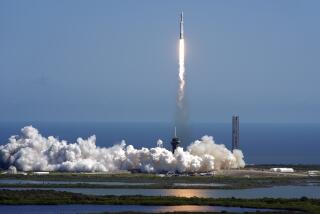NASA signs on for mission to Mercury; craft to arrive in 2022
NASA has signed on to a mission to explore Mercury, the closest planet to the sun.
NASA Administrator Charles Bolden inked the agreement to join the BepiColombo mission Thursday in Rome. The mission is already being built and tested by the European Space Agency. Enrico Saggese, president of the Italian Space Agency, also signed the memorandum of understanding.
As currently designed, BepiColombo will include two spacecraft that will orbit Mercury and map the planet at multiple wavelengths. The Mercury Planetary Orbiter (MPO) and the Mercury Magnetospheric Orbiter (MMO) “will chart the planet’s mineralogy and elemental composition, determine whether the interior of the planet is molten or not, and investigate the extent and origin of Mercury’s magnetic field,” according to the mission website.
The two craft will launch as a unit and make their way toward the center of the solar system with the help of a solar-electric propulsion system and the gravity of three planets -- Earth, Venus and Mercury. When they reach their destination in 2022, the two probes will establish a polar orbit around Mercury before they separate, allowing MPO to descend closer to the planet’s surface.
PHOTOS: Stunning views of the Sun
Scientists hope the mission will help them understand how rocky planets, including Earth, formed in the early solar system. What they learn could inform the study of Earth-like planets orbiting other stars.
Mercury is tough to study from Earth because it’s only about 36 million miles away from the Sun, which is obviously much brighter in the sky. Sending a spacecraft isn’t easy either. The Sun’s overwhelming gravity makes it tough to steer a probe into a stable orbit.
Only two crafts have been sent from Earth to Mercury before. NASA’s Mariner 10 was the first to visit Mercury, flying by the planet three times in 1974 and 1975 after visiting Venus. Mariner 10 took pictures of the planet’s Moon-like surface and determined that the planet had an iron-rich core, a small magnetic field and no atmosphere.
NASA’s Messenger flew past Mercury three times in 2008 and 2009, then became the first craft to orbit the innermost planet in 2011. The craft found water ice on Mercury’s north pole, which never points toward the Sun. As much as 1.1 trillion tons of ice could be frozen on the planet, scientists now estimate. Messenger is still circling Mercury, and you can track its orbits on the mission website.
BepiColombo marks the first time the European Space Agency has sent a spacecraft toward the Sun. An ESA Mercury mission has been under consideration since 1994.
ALSO:
Messenger detects frozen water, organic matter on Mercury
Messenger mission reveals surprises on — and inside — Mercury
Return to Science Now.







